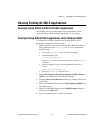Chapter 3 Developing Your NI-488.2 Application
© National Instruments Corporation 3-11 NI-488.2 User Manual for Windows
Step 2. Determine the GPIB Address of Your Device
Use
FindLstn
to find all the devices attached to the GPIB. The
FindLstn
function requires the following parameters:
• Interface number (typically 0, for
GPIB0
).
• A list of primary addresses, terminated with the
NOADDR
constant.
• A list for reported GPIB addresses of devices found listening on the
GPIB.
• Limit, which is the number of the GPIB addresses to report.
Use
FindLstn
to test for the presence of all of the primary addresses that
are passed to it. If a device is present at a particular primary address, then
the primary address is stored in the GPIB addresses list. Otherwise, all
secondary addresses of the given primary address are tested, and the GPIB
address of any devices found are stored in the GPIB addresses list. When
you have the list of GPIB addresses, you can determine which one
corresponds to your instrument and use it for subsequent calls.
Alternately, if you already know your GPIB device’s primary and
secondary address, you can create an appropriate GPIB address to use in
subsequent NI-488.2 calls, as follows: a GPIB address is a 16-bit value that
contains the primary address in the low byte and the secondary address in
the high byte. If you are not using secondary addressing, the secondary
address is 0. For example, if the primary address is 1, then the 16-bit value
is 0x01; otherwise, if the primary address is 1 and the secondary address is
0x67, then the 16-bit value is 0x6701.
Step 3. Initialize the Devices
Use
DevClearList
to clear the devices on the GPIB. The first argument
is the GPIB interface number. The second argument is the list of GPIB
addresses that were found to be listening as determined in Step 2.
Device Communication
Step 4. Communicate with the Devices
Communicate with the devices by sending them the
"*IDN?"
query and
then reading back the responses. Many devices respond to this query by
returning a description of the device. Refer to the documentation that came
with your GPIB devices to see specific instruction on the proper way to
communicate with them.


















